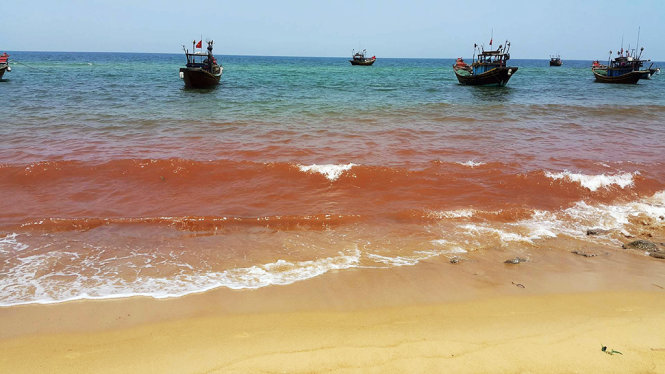Remember the streak of reddish sea water that appeared along the shoreline of a beach in the north-central province of Quang Binh in May, when a spate of fish deaths occurred in central Vietnam?
The strange phenomenon of the sea water has played a crucial role in unraveling the mysterious fish deaths, scientists have said, after the ‘culprit’ behind the environmental disaster was named last week.
On Thursday, the Vietnamese government announced during a press conference that the Vietnamese steel business of Taiwan’s Formosa Plastics Group in the north-central province of Ha Tinh had admitted it was the cause of the fish death epidemic in central Vietnam between April and May.
The company apologized to Vietnam’s government and its people, and pledged US$500 million in damages for recovery efforts in the four affected Vietnamese provinces, namely Ha Tinh, Quang Binh, Quang Tri and Thua Thien-Hue.
The search for what was behind the dead fish had been led by the Ministry of Science and Technology.
A national-level scientific panel, steered by the head of the Vietnam Academy of Science and Technology, was also formed to discover the cause, involving nearly 100 experts from 30 different institutions.
The scientists have recalled how their extensive efforts have now paid off.

Finding the missing piece
The mission had begun with scientists conducting numerous studies and tests, evaluating causes including a potential oil spill, an earthquake, epidemic outbreaks or red tide, a result of algae blooming at an abnormal rate and producing toxins.
However, results from satellite data, seismic analysis and sea water tests rejected all those hypotheses.
Analysis of the sediment samples collected from waters of the four affected provinces also found no excessive amounts of toxicity, frustrating the scientists.
However, just as the experts were scratching their heads, the reddish sea water phenomenon was reported, delivering the missing piece of the puzzle.
On May 4, a 1.5km stretch of sea water in Quang Binh was found to be turning red for nearly four hours in the morning, drawing special attention from the scientists.
A streak of black sea water emerged in Ha Tinh on May 6, and waters near the Son Duong Port in this province also turned red on May 12.
Scientists immediately collected samples of all of those abnormal waters for tests, with results eventually proving the waters contained high levels of ferric hydroxide and phenol, a toxic substance.
 Scientists examine the abnormal waters.
Scientists examine the abnormal waters.
Experiments in which live fish were put into those waters were also conducted, with the aquatic animals dying within three to 30 minutes into the unusually colored waters.
Analysts later identified that those streaks of water did not owe their strange colors to either algae blooming or natural alluvial soil, but were in fact “a net of glue that absorbed such toxic substances as phenol and cyanide” and were “results of wastewater dumping activities by humans.”
Results of separate tests by the Vietnam Academy of Science and Technology, the Vietnamese Ministry of Health and the University of Sydney later revealed high levels of phenol and cyanide in the fish washed ashore from the affected waters.
These findings led to the conclusion that there must be a source that discharged dirty water with high levels of those toxic substances that caused fish to die en masse.

The “net of glue,” formed by a mixture of phenol, cyanide and ferric hydroxide,” became a “mobile hub of toxins” that was brought by the current from Ha Tinh to Thua Thien-Hue, killing all aquatic creatures along its path.
The reddish sea water was caused by the mixture of substances pushed to the sea surface by strong tides and waves.
Scientists then identified that the cyanide and phenol could only stem from the coking process at the Formosa steel plant, whereas the ferric hydroxide was sent out during the cleaning of its pipelines.
When combining, these all led to the final conclusion that Formosa had caused the fish deaths, which the company was unable to deny.
Like us on Facebook or follow us on Twitter to get the latest news about Vietnam!





















































